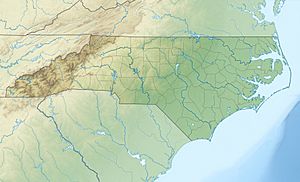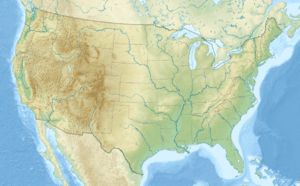Jennie Wolf Creek facts for kids
Quick facts for kids Jennie Wolf Creek |
|
|---|---|
|
Location of Jennie Wolf Creek mouth
|
|
| Other name(s) | Tributary to Dutch Buffalo Creek |
| Country | United States |
| State | North Carolina |
| County | Cabarrus Rowan |
| Physical characteristics | |
| Main source | Second Creek divide about 2 miles south-southeast of Shupings Mill, North Carolina 780 ft (240 m) 35°31′38″N 080°21′20″W / 35.52722°N 80.35556°W |
| River mouth | Dutch Buffalo Creek about 2 miles south of Watts Crossroads, North Carolina 598 ft (182 m) 35°26′31″N 080°27′17″W / 35.44194°N 80.45472°W |
| Length | 6.67 mi (10.73 km) |
| Basin features | |
| Progression | south-southeast |
| River system | Pee Dee River |
| Basin size | 8.98 square miles (23.3 km2) |
| Tributaries |
|
| Bridges | Graystone Road, Sisk-Carter Road, Kluttz Road, Gold Hill Road |
Jennie Wolf Creek is a small stream, about 6.67 miles (10.73 km) long, located in North Carolina, United States. It's like a smaller river that flows into a bigger one called Dutch Buffalo Creek. This particular stream is the only one in the entire United States with the name Jennie Wolf Creek!
What's in a Name?
Sometimes, places have more than one name over time. According to the Geographic Names Information System, Jennie Wolf Creek has also been known by another name in the past:
- Schene Wolf Creek
Where Does Jennie Wolf Creek Flow?
Jennie Wolf Creek starts its journey about 2 miles (3.2 km) south-southeast of a place called Shupings Mill in Rowan County.
From there, it flows generally towards the south-southeast. It then enters Cabarrus County. Finally, it joins up with Dutch Buffalo Creek about 2 miles (3.2 km) south of Watts Crossroads.
About the Watershed
A watershed is like a big bowl that collects all the rain and snow that falls in an area, and then drains it into a stream or river. The Jennie Wolf Creek watershed covers about 8.98 square miles (23.26 sq km).
This area gets about 46.9 inches (119 cm) of rain each year. About 54% of the land in this watershed is covered by forests. This means there are lots of trees that help keep the water clean and provide homes for wildlife.



